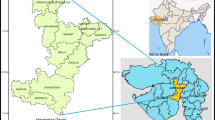Abstract
Groundwater vulnerability to contamination is becoming a major issue in urban settlement territories due to multiple anthropogenic activities. Akaki well fields supply 30% of the domestic water for Addis Ababa city, However, these well fields are highly vulnerable to contamination as these well fields are located downstream of the city, and assessment of groundwater vulnerability to contamination is essential. The present study investigates the vulnerability of Akaki well fields to contamination using the GIS DRASTICA method. DRASTICA stands for depth to water level (D), recharge (R), aquifer (A), soil (S), topography (T), impact of vadose zone (I), hydraulic conductivity (C), and anthropogenic activities (A). To generate the groundwater vulnerability to contamination, the method considered these eight parameters. Groundwater samples were collected from twenty boreholes for laboratory analysis to determine the water quality index. This water quality index was used to validate the DRASTICA method besides nitrate concentration. The DRASTICA method identified five vulnerability zones such as very low, low, moderate, high, and very high. According to the result of the DRASTICA method, 7.68% of the study area has a very low class of groundwater vulnerability zone, 24.54% is low class, 28.91% is moderate class, 29.85% is high class, and 9.02% of the study area has a very high class of vulnerability zone. Sensitivity analysis reveals that the impact of a vadose zone is the most influential parameter of the vulnerability index. The correlation between the DRASTICA index and nitrate was R2 = 0.95 which indicated that the DRASTICA method has the best relation with actual pollution substances found in the groundwater. Those well fields that have high water quality index were found in the very high vulnerability zone of the DRASTICA index. Thus, both water quality index and nitrate concentration were found to be correlated with the method.














Similar content being viewed by others
References
Aller L, Bennet T, Lehr J, Hacket G (1987) DRASTIC : a standardized system for evaluating groundwater pollution potential using hydrogeologic settings.United States: Environmental Protection Agency
Barbulescu A (2020) Assessing groundwater vulnerability: DRASTIC and DRASTIC-like methods: a review. Water 12(5):1356. https://doi.org/10.3390/w12051356
Chilton J (1996) Water quality assessments—a guide to the use of biota, sediments, and water in environmental monitoring, 2nd edn. Great Britain at the University Press, Cambridge
Honarbakhsh A, Tahmoures M, Tashayo B, Mousazadeh M, Ingram B, Ostovari Y (2019) GIS-based assessment of groundwater quality for drinking purposes in the northern part of Fars province, Marvdasht. J Water Supply 68(3):187–196
Ibrahim MN (2019) Assessing groundwater quality for drinking purpose in Jordan : application of water quality index. J Ecol Eng 20(3):101–111
Krishna R, Iqbal J, Gorai AK, Pathak G, Tuluri F, Tchounwou PB (2015) Groundwater vulnerability to pollution mapping of Ranchi district using GIS. Appl Water Sci 5:345–358. https://doi.org/10.1007/s13201-014-0198-2
Kumar S, Thirumalaivasan D, Radhakrishnan N (2013) GIS-based assessment of groundwater vulnerability using a DRASTIC model. Arab J Sci Eng 39(1):207–216
Margat J (1968) Vulnérabilité des nappes d'eau souterraine à la pollution (Vulnerability of groundwater to pollution). Orléans, France: BRGM Publication 68 SGL 198 HYD.
Maria R (2018) Comparative studies of groundwater vulnerability assessment. IOP Conf Ser Earth Environ Sci 118:012018
Mohamed AK, Dan L, Kai S, Eldaw E, Abualela S (2019) Evaluating the suitability of groundwater for drinking purposes in the North Chengdu Plain, China. E3S Web Conf 81:01006
Morris BL, Lawrence ARL, Chilton PJC, Adams BCCR, Klinck BA (2003) Groundwater and its susceptibility to degradation: a global assessment of the problem and options for management. Early warning and assessment report series, RS. 03–3. United Nations Environment Programme, Nairobi, Kenya.
Nagaraju A, Thejaswi A, Sreedhar Y (2016) Assessment of groundwater quality of Udayagiri area, Nellore District, Andhra Pradesh, South India using multivariate statistical techniques. Earth Sci 20(4):1–7
National Research Council (1993) Groundwater vulnerability assessment: predicting relative contamination potential under conditions of uncertainty. The National Academies Press, Washington, DC
Oke IA, Lukman S, Ismail A (2017) Development and performance evaluation of a new numerical model for groundwater recharge estimation. Nigeria J Eng 23(2):56–65
Patel Y, Vadoria G (2018) Groundwater quality assessment using water quality index. Research gate. https://www.researchgate.net/publication/326175316. Accessed 4 Jan 2022
Qian H, Li P, Howard KWF (2011) Assessment of groundwater vulnerability in the Yinchuan Plain, Northwest China using OREADIC. Environ Monit Assess 184:3613–3628
Rao A, Kumar V, Rao D, Naik P (2018) Assessment of vulnerability zones for groundwater pollution using GIS-DRASTIC-EC model: a field-based approach. J Earth Syst Sci 127(4):1–24
Shiklomanov IA (1998) World water resources: a new appraisal and assessment for the 21st century. In: United Nations Educational, Scientific and Cultural Organization.
Subramanya K (2008) Engineering hydrology, 3rd edn. McGraw-Hill, New Delhi
Thapa R, Gupta S, Guin S, Kaur H (2018) Sensitivity analysis and mapping the potential groundwater vulnerability zones in Birbhum district, India: a comparative approach between vulnerability models. Water Sci 32(1):44–66
Tolera MB, Choi H, Chang SW (2020) Groundwater quality evaluation for different uses in the lower Ketar Watershed, Ethiopia. Environ Geochem Health 42:3059–3078. https://doi.org/10.1007/s10653-019-00508-y
Tuinhof A, Foster S, Steenbergen F van Talbi A, Wishart M (2011) Sustainable groundwater management contributions to policy promotion of appropriate groundwater management policy for Sub-Saharan Africa. Strategic Overview Series Number 5, working paper
Villumsen A, Jacobsen OS, Sonderskov C (1983) Mapping the vulnerability of groundwater reservoirs concerning surface pollution. Danm Geol Unders Arbog 1982:17–38
WHO (2008) Guidelines for drinking-water quality: incorporating the first and second Addenda. World Health Organization Press, Geneva
Funding
Ethiopian Ministry of Education is the funding Agency for this paper.
Author information
Authors and Affiliations
Corresponding author
Additional information
Publisher's Note
Springer Nature remains neutral with regard to jurisdictional claims in published maps and institutional affiliations.
Rights and permissions
About this article
Cite this article
Dugassa, L., Abate, B. Assessment on contamination vulnerability of Akaki well fields using GIS and DRASTICA methods. Sustain. Water Resour. Manag. 8, 94 (2022). https://doi.org/10.1007/s40899-022-00687-0
Received:
Accepted:
Published:
DOI: https://doi.org/10.1007/s40899-022-00687-0




